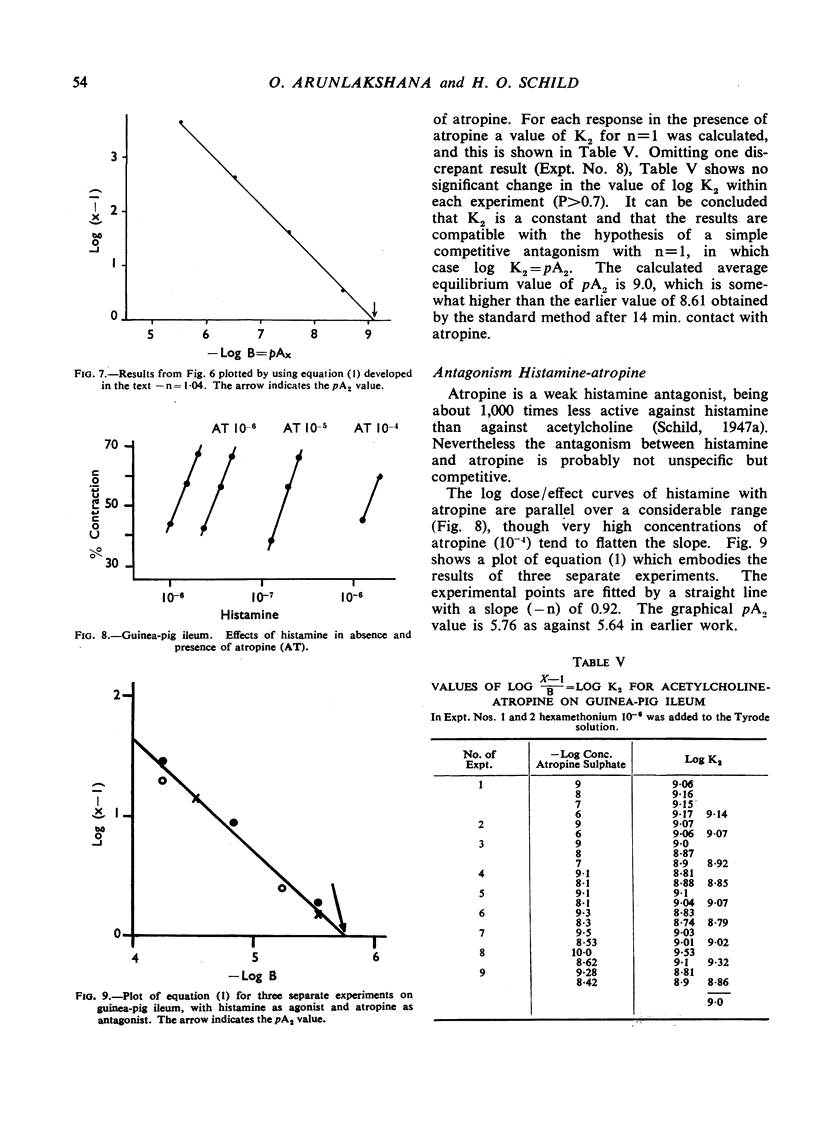Abstract
Various applications of pAx measurements are discussed based on the hypothesis that drugs and drug antagonists compete for receptors according to the mass law. Examples are given illustrating the use of pAx measurements to identify agonists which act on the same receptors and to compare the receptors of different tissues. Tests of competitive and noncompetitive antagonism are considered in relation to the antagonisms acetylcholine-atropine, histamine-atropine and acetylcholine-cinchonidine. A new measure, pAh, is introduced to express the activity of unsurmountable antagonists.
Full text
PDF










Selected References
These references are in PubMed. This may not be the complete list of references from this article.
- ARUNLAKSHANA O., SCHILD H. O. The air-perfused bronchial tree. J Physiol. 1950 Apr;111(1-2):48p–48p. [PubMed] [Google Scholar]
- BOURA A., MONGAR J. L., SCHILD H. O. Improved automatic apparatus for pharmacological assays on isolated preparations. Br J Pharmacol Chemother. 1954 Mar;9(1):24–30. doi: 10.1111/j.1476-5381.1954.tb00811.x. [DOI] [PMC free article] [PubMed] [Google Scholar]
- Clark A. J. The antagonism of acetyl choline by atropine. J Physiol. 1926 Aug 6;61(4):547–556. doi: 10.1113/jphysiol.1926.sp002315. [DOI] [PMC free article] [PubMed] [Google Scholar]
- DEL CASTILLO L., KATZ B. A study of curare action with an electrical micromethod. Proc R Soc Lond B Biol Sci. 1957 May 7;146(924):339–356. doi: 10.1098/rspb.1957.0015. [DOI] [PubMed] [Google Scholar]
- FURCHGOTT R. F. The pharmacology of vascular smooth muscle. Pharmacol Rev. 1955 Jun;7(2):183–265. [PubMed] [Google Scholar]
- GADDUM J. H., HAMEED K. A., HATHWAY D. E., STEPHENS F. F. Quantitative studies of antagonists for 5-hydroxytryptamine. Q J Exp Physiol Cogn Med Sci. 1955 Jan;40(1):49–74. doi: 10.1113/expphysiol.1955.sp001097. [DOI] [PubMed] [Google Scholar]
- HAWKINS D. F., SCHILD H. O. The action of drugs on isolated human bronchial chains. Br J Pharmacol Chemother. 1951 Dec;6(4):682–690. doi: 10.1111/j.1476-5381.1951.tb00680.x. [DOI] [PMC free article] [PubMed] [Google Scholar]
- NICKERSON M. Nonequilibrium drug antagonism. Pharmacol Rev. 1957 Jun;9(2):246–259. [PubMed] [Google Scholar]
- SCHILD H. O. Non-competitive drug antagonism. J Physiol. 1954 May 28;124(2):33–4P. [PubMed] [Google Scholar]
- SHANES A. M. Electrochemical aspects of physiological and pharmacological action in excitable cells. I. The resting cell and its alteration by extrinsic factors. Pharmacol Rev. 1958 Mar;10(1):59–164. [PubMed] [Google Scholar]
- SKOU J. C. Local anaesthetics. VI. Relation between blocking potency and penetration of a monomolecular layer of lipoids from nerves. Acta Pharmacol Toxicol (Copenh) 1954;10(4):325–337. doi: 10.1111/j.1600-0773.1954.tb01349.x. [DOI] [PubMed] [Google Scholar]
- WILBRANDT W. Zur Frage des Wirkungsmechanismus der Antihistaminsubstan zen. Helv Physiol Pharmacol Acta. 1950;8(4):399–408. [PubMed] [Google Scholar]


